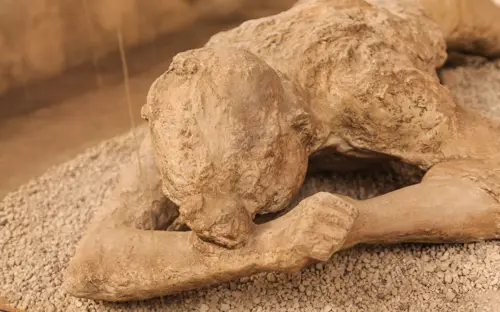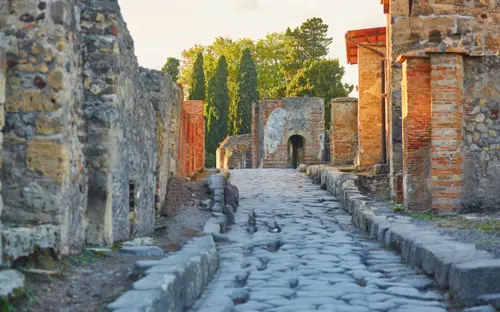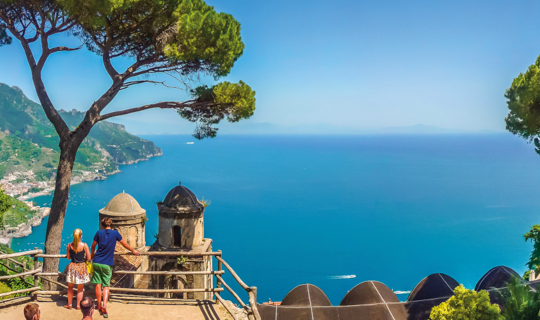THINGS TO DO IN POMPEII – TOP 12 SIGHTS
Whether you explore just a few or manage to visit them all, each of these highlights captures the very best of Pompeii’s fascinating history.
1. The Forum
Once the beating heart of city life, the Forum was the centre of politics, religion and daily gatherings.
This grand rectangular square is framed by colonnades, with Mount Vesuvius looming beyond. Temple podiums, the Basilica’s civic halls and remains of the Macellum market are laid out with striking clarity.
Stand for a moment and imagine the space filled with senators debating, traders haggling and citizens gathering for ceremonies.
2. Stabian Baths or Forum Baths

Pompeii’s public bathhouses were more than just places to wash and relax. They were lively social hubs, complete with colourful mosaics and sophisticated underfloor heating.
The Stabian Baths are the oldest in Pompeii, with a spacious layout and beautiful frescoes. Meanwhile, the smaller Forum Baths are famous for their intricate stucco details and more intimate atmosphere.
One of the best things to do in Pompeii is to follow in the footsteps of the Romans as you move from the apodyterium (changing rooms) to the palaestra, used for exercise, to the frigidarium (cold room), the tepidarium (warm room), and the caldarium (hot room).
3. Forum Granary
Just off the Forum, the so-called “Granary” is where hundreds of amphorae, roof tiles and household objects, many recovered from the ash, are gathered.
You can even see haunting plaster casts of Pompeii’s last residents here – a tribute to the citizens who were unable to escape the volcano’s devastation. The Granary is a moving reminder of both ordinary life and sudden tragedy, with objects frozen in time by the eruption.
4. The Amphitheatre
Constructed around 70 BC, Pompeii’s incredible amphitheatre is one of the oldest surviving Roman arenas. Here, you can imagine crowds of 20,000 spectators cheering and roaring as gladiators fought each other and teams of skilled fighters hunted wild beasts.
You might take the opportunity to stand in the centre of the arena, or make the climb up the stone steps to take in the view as the Romans once did.
5. The Large Theatre and Odeon

This elegant, horseshoe-shaped theatre was the stage for tragedies and comedies, with the smaller Odeon (Teatro Piccolo) offering a more intimate venue for concerts and poetry readings.
Together, the venues helped to build Pompeii’s reputation as an entertainment capital of the ancient world.
Climb the Large Theatre’s seating for lovely views across tiled roofs and cypress trees. Thanks to skilful Roman acoustics, a whisper on stage carries up the steps. Close your eyes and you can almost hear the strum of a lyre and the murmur of an audience settling in for a performance.
6. House of the Faun
This vast mansion spans an entire city block and was home to one of Pompeii’s elite families.
Its name comes from the graceful bronze dancing faun in the atrium, and it houses a replica of the celebrated Alexander Mosaic (the original is now in the National Archaeological Museum of Naples).
The unknown owners spared no expense on their grand home, adorning every room with exquisite mosaics and sculptures.
Wander through multiple courtyards, colonnades and impressive reception rooms. Admire the intricate Nilotic floor mosaics and the playful Satyr and Nymph scene.
You can’t help but marvel at the sheer scale and artistry still evident here centuries later.
7. House of the Vettii
This opulent townhouse, once owned by wealthy Freedmen brothers, is a popular stop on any tour of Pompeii’s highlights. Its vivid wall frescoes of mythological scenes and elegant courtyards offer a glimpse into the luxurious lives of Pompeii’s wealthy residents.
Take your time to enjoy the preserved artwork, including the infamous ‘Priapus’ painting, as you wander through the impressive rooms. The House of the Vettii is on the Via del Vesuvio.
8. Villa of the Mysteries

A short stroll beyond the city walls takes you to this spacious countryside villa famous for its striking and elaborate frescoes.
The famous “mysteries” room is encircled with life-size figures, and the walls are deep Pompeian red. The scenes are thought to show the secret initiation rituals of a Dionysian cult.
The villa’s setting, surrounded by vineyards, adds to the atmosphere. Step into the cool interior and let your eyes adjust – the painted drapery and lifelike gazes from the wall paintings seem startlingly alive.
9. Lupanar
The Lupanar is one of the most interesting things to do in Pompeii, and a visit to the notorious brothel reveals one of the best-preserved examples from the Roman world. Tucked away on a side street, its compact rooms are adorned with explicit frescoes, believed to have been both decoration and a visual menu for clients.
Fascinating graffiti carved into the walls reveals names, jokes and even reviews left by customers and workers. Lupanar offers a candid – and often entertaining – glimpse into Pompeii’s social attitudes and morality, shining a light on the everyday reality of residents whose stories are rarely told.
10. Garden of the Fugitives

This poignant site sits near the southern edge of Pompeii. It’s a preserved vineyard that is also home to plaster casts of 13 men, women and children who were overcome by volcanic ash as they tried to escape the eruption of Mount Vesuvius.
You’ll see figures in sobering detail – shielding children, clutching bags, faces turned away from heat and ash.
Today, the casts are thoughtfully displayed among rows of ancient vines. The garden itself has been replanted with newer grapevines, allowing you to imagine Pompeii’s once-flourishing vineyards and the daily life that continued up to the city’s final moments.
11. Thermopolia and Pistrina (Street Food and Bakeries)
Did you know we have the Romans to thank for fast food? Thermopolia were counters with dolia (jars) sunk into the top, serving hot stews and wine spiced with herbs. You’ll find several beautifully preserved examples with colourful fresco panels.
Pompeii’s bakeries, or pistrina, are some of the most evocative sites in the city. Inside, you’ll see the heavy basalt millstones once turned by mules, while large brick ovens dominate the rooms.
Some bakeries even have a sales counter facing the street, where locals would buy fresh bread daily. Others show evidence of commercial-scale production to supply the wider city. Archaeologists have found carbonised loaves of bread inside, perfectly preserved by the eruption’s heat.
12. Street Life and Urban Engineering

Look down as much as you look up. Pompeii’s urban planning is a marvel in itself.
You’ll see raised stepping-stones at junctions, allowing pedestrians to cross when rainwater flows through the streets; between them, deep cart ruts record centuries of traffic.
Spot kerbstones, terracotta drain covers and thresholds with high step-ups. Public fountains stand on street corners fed with water from a city-wide aqueduct system.
If time allows, other worthy things to do in Pompeii include the Temple of Apollo, Temple of Jupiter, the Temple of Isis, the Suburban Baths, the Palaestra, the House of the Tragic Poet, the city walls, Porta Nocera necropolis and the Villa of Diomedes.

















